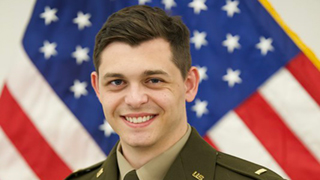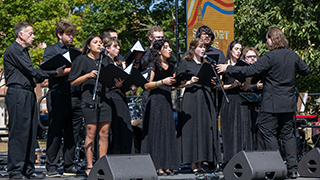Intertwining Departments - ROTC Cadet’s Diplomacy Independent Study Project
Monday, July 3, 2023

Cadet Istvan Varga
As Cadet Istvan Varga was entering his final semester at Seton Hall, he wanted to complete a project that combined his two passions: the military and diplomacy. Following his capstone project for the School of Diplomacy and International Relations, which examined a cost-benefit analysis of Sweden and Finland joining the North Atlantic Treaty Organization (NATO), and his four years in the Reserve Officer Training Course (ROTC) and the Department of Military Science, Cadet Varga found the perfect way to blend the two in an independent study focusing on national defense strategy and the application of integrated deterrence.
The School of Diplomacy and the Department of Military Science have longstanding relationships. This year the ROTC Pirate Battalion commissioned fifteen students as Second Lieutenants in the United States Army. Of those fifteen cadets, five students were part of the School of Diplomacy and International Relations, including Cadet Varga. While Cadet Varga was proud of his work in his diplomacy research project, he wanted to expand that work in a practical and tangible way. Because he has always been interested in the relationship between diplomacy and the military, he talked to Lieutenant Colonel Adam Scher, Professor of Military Science and Director of the Army ROTC Program, about his work with the Department of Defense. During that conversation, Cadet Varga decided to do an independent study with Colonel Scher to prepare him for his future as a military intelligence officer in the Army.
Cadet Varga’s independent study focused on a recent topical project, the Russian invasion of Ukraine. The conflict and international security aspects of diplomacy fascinated him. After taking Assistant Professor Sara Moller’s International Conflict and Security class, he wanted to dive deeper into some of the topics they discussed in that class. Using the recent National Defense Strategy and examining the policy side of this profession, Cadet Varga analyzed and assessed the integrated deterrence of the National Defense Strategy and used the Russian war in Ukraine as a case study.
While still a relatively new theory, integrated deterrence calls for integrating all tools in a state's toolbox with its allies to deter aggression. In his paper, Cadet Varga defined what a successful integration of deterrence looked like based on three qualifiers. He concluded that integrated deterrence was successful overall, but it came down to the degree to which it worked. Integrated deterrence of the US and NATO did not successfully prevent conflict, but it did a good job of containing it. Integrated deterrence also succeeded in expanding integration and posing the U.S. with its allies and partners works well in times of conflict. Still, he argues that it can work to be implemented in times of peace.
Once he finished his project, Cadet Varga presented it to his advisor and fellow students, the Department of Military Science faculty, and it was shared among the Department of Military Science and the School of Diplomacy. In addition to his class with Assistant Prof. Moller, Cadet Varga credits Research Methods with Professor R. Joseph Huddleston, Ph.D., and the research project with Professor Benjamin Goldfrank, Ph.D. for giving him the tools necessary to complete this project.
As he has just graduated and is looking forward to his future career, he left some advice for his fellow diplomacy students to “branch out early on and try a bunch of different things because diplomacy is a mixture. The more you know about the mixture, the better you can personalize your research and projects when the time comes.”






